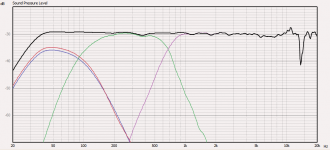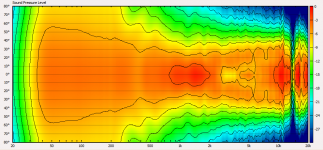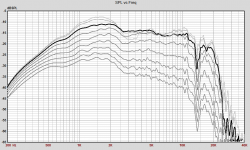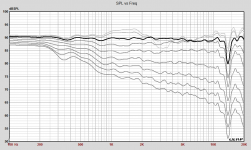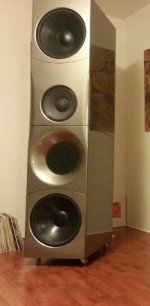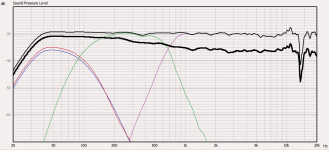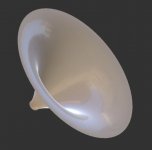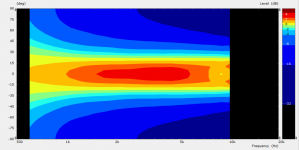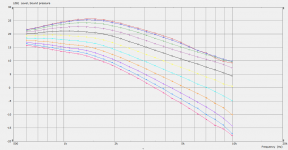To match directivities doesn't mean you must be matching a narrowing one (with a rising DI) to a constant one (like a 15" woofer + 18"WG at 800 Hz). Both the sources can have rising DI around the crossover frequency, i.e. the horn doesn't have to be that big you imply. Once the directivities match there's no problem.The most important things are matching the directivity at the crossover, which becomes almost untenable for waveguide size as the crossover point moves down. Almost no one here seems to be looking at the directivity control of these larger horns at their lower end. I highly doubt that they control directivity down to the "cutoff" point that they claim.
I would say it's even easier to do lower in frequency so that the transition can be smoother overall.
Last edited:
Yes, one of several coax options.
Would it work in that configuration?
i've never seen it done but anythings possible...i would hazard mid high reponse would be chaotic....
Dr Geddes could surely tell you more...if inclined?
This is a 12" woofer mated to 18" OSWG at 650 Hz. Compression drivers is 1,4" (18sound ND1460A). The waveguide used is not the best possible - I know better now.
OK, the driver has this hole around 14 kHz - I could live with that.
OK, the driver has this hole around 14 kHz - I could live with that.
Attachments
I was using a SEOS-24, 1.4" with Radian 745be for a while, Xover at 650hz. It does some things very well. Huge dynamics and smooth measuring (on axis) past 20khz. Vocal sound fantastic and image is great.
Seems like some beaming at the high end of the frequency spectrum changes the in room presentation a bit (at least in my room). Tried integrating a uhf driver into with varying degrees of success. One day sounds good, another day maybe something isn't quite right. Seemed like a lot of fiddling.
I will get back to it one day but was very pleased with the DE360 high frequency presentation but Xover moved to 1100hz
Trade offs........with higher xover and loss of pattern control higher in frequency you miss some the low crossover magic of the sound presentation but gain slightly better hf presentation (in my room). Sometimes you need to pick a poison. Would be nice to bridge the gap at some point but we are talking a really small gap anyways so.........
I found a larger difference to be had in OB midbass. The midbass presentation of OB is better than sealed in my room so it's fun setting up a Frankenstein system. Your room might behave different.
Seems like some beaming at the high end of the frequency spectrum changes the in room presentation a bit (at least in my room). Tried integrating a uhf driver into with varying degrees of success. One day sounds good, another day maybe something isn't quite right. Seemed like a lot of fiddling.
I will get back to it one day but was very pleased with the DE360 high frequency presentation but Xover moved to 1100hz
Trade offs........with higher xover and loss of pattern control higher in frequency you miss some the low crossover magic of the sound presentation but gain slightly better hf presentation (in my room). Sometimes you need to pick a poison. Would be nice to bridge the gap at some point but we are talking a really small gap anyways so.........
I found a larger difference to be had in OB midbass. The midbass presentation of OB is better than sealed in my room so it's fun setting up a Frankenstein system. Your room might behave different.
Last edited:
That's what I intend to try for a long time. 18" woofer in some form of an open baffle (cardioid if possible) and 20" WG with 18sound ND4015. Together with some subwoofers. Must be a killer system.I found a larger difference to be found in OB midbass. The midbass presentation of OB is better than sealed in my room so it's fun setting up a Frankenstein system. Your room might behave different.
That's what I intend to try for a long time. 18" woofer in some form of an open baffle (cardioid if possible) and 20" WG with 18sound ND4015. Together with some subwoofers. Must be a killer system.
You should definitely try it. I think you will be enjoy it! I found below 50hz gets difficult for OB in my room so either EQ a lot or sealed eq subs below that might be easier. Either way try it! Nothing really to loose except some $$$ on a woofer and some wood.
I’ve always wondered what that design would sound like with a coaxial driver? (Without the top)
Anyone ever try that?
And if you could miniaturize to say a 8” coax setup just like that ‘loaded slot horn’ (or whatever that is called?) over a 15” bottom?
Bob
Altec 19: The Remix - AudioReview
Not the VOTT but the Altec 19 revisited. And the crossover between wf and coax is elctronic.
To match directivities doesn't mean you must be matching a narrowing one (with a rising DI) to a constant one (like a 15" woofer + 18"WG at 800 Hz). Both the sources can have rising DI around the crossover frequency, i.e. the horn doesn't have to be that big you imply. Once the directivities match there's no problem.
I would say it's even easier to do lower in frequency so that the transition can be smoother overall.
It is true that one can match DI level and slope, which is the ideal, but most horns and waveguide suffer from midrange narrowing where the DI starts to rise then falls and rises again. You can see that in the plots that you show. Perhaps this is not too bad, but then neither is using a higher crossover point past the narrowing. That has always been my approach. High DI is clearly a benefit at upper frequencies, but I discount its importance as the frequency falls.
Maybe 1.4" is a good compromise, I never went there. I did try 2" CDs and they could not get above 10 kHz without problems. The 1.4" "seems" to work OK, although you can see some problems above 10 kHz. Clearly you can see that going down to 600 Hz Xover yields a poorer response at 10kHz. This is the tradeoff that I have always found. I will not argue that one should be obsessed with HFs above 8kHz though as I would agree that this region has little influence on quality. But the midrange narrowing does concern me.
I've already everything except the waveguide. That I would like to make myself (for the first time). Wish me luck.
Good luck! If you want to make a waveguide like I recommend PM me and I can help you move forward as I have made lots and lots of waveguides. But I am not too interested in making horns.
Last edited:
I will get back to it one day but was very pleased with the DE360 high frequency presentation but Xover moved to 1100hz
Trade offs........with higher xover and loss of pattern control higher in frequency you miss some the low crossover magic of the sound presentation but gain slightly better hf presentation (in my room). Sometimes you need to pick a poison. Would be nice to bridge the gap at some point but we are talking a really small gap anyways so.........
The 88-Special kit comes with a SEOS-15, a DNA-360 compression driver and a pair of high-efficiency 16 ohm 8” midbass drivers (as well as a baffle, some ports, and some crossover components). When used as intended, the crossover point to the woofer array is 950Hz. Were one to internally mount and slot-load the woofers on either side of the waveguide, they could be repurposed to extend the directivity pattern control down another half-octave (see Bill Waslo’s fade-to-array trick). While no longer strictly a “two-way”, one could gain the benefits of pattern control to a lower frequency that with the waveguide alone, as well as lessening the HF requirements of the woofer, possibly even crossing over to a 18”.
Unlike trying to buy these devices individually, the 88-Special kit is in stock.
I believe that by a generous mouth flare much of the narrowing can be overcome. At least it seems to be the case based on my simulations so far, for waveguides and also for horns.... But the midrange narrowing does concern me.
BTW, this is one of the best horns I came across in my endeavour (about 18"): Acoustic Horn Design – The Easy Way (Ath4)
Same or actually better results can be achieved with waveguides so I will probably stick with them. It's all about the mouth treatment.
Last edited:
Thanks. It will be something like this. I think you would approve.
If the real thing works that well then you really have something.
I would likely agree to that, there is some reason to believe that would be the case in general. But the radius takes up a lot of space. That's its downside.I believe that by a generous mouth flare much of the narrowing can be overcome. At least it seems to be the case based on my simulations so far, for waveguides and also for horns.
BTW, this is one of the best horns I came across in my endeavour (about 18"): Acoustic Horn Design – The Easy Way (Ath4)
Same or actually better results can be achieved with waveguides so I will probably stick with them. It's all about the mouth treatment.
I think that the throat is very important as well.
Can you get me the actual contour used?
Banding? In the midrange? Oh wait you are talking about all the horns that aren’t a traditional round long horn oooook har har har har =)
I was trying to figure out why I thought matching polars was easy, it’s because with the style of horn I chose, it is easy
I was trying to figure out why I thought matching polars was easy, it’s because with the style of horn I chose, it is easy
Last edited:
Altec 19: The Remix - AudioReview
Not the VOTT but the Altec 19 revisited. And the crossover between wf and coax is elctronic.
Thanks Pico, I was thinking more like the semi slot flare like the vott has except replacing it with a coax....no CD on top.
what is the technical term for that particular arrangement on the vott bottom?
is this what you mean?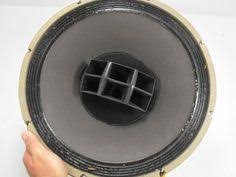
Yeah, played with a 604E in an A7 cab; it was OK, had the horn boost of course, so made it more 'throaty', but allowed the HF horn to be opened up a bit.
Was exposed to an original A6 [less the upper, lower baffle] for several years and it was a better overall performer, but quite a bit bigger: http://www.voiceofthetheatre.com/images/vottcatt1945.10.jpg
GM
Actually, just remembered someone made some nice drawings [auto download]: http://forums.melaudia.net/attachment.php?aid=6487
Good thing as they were pretty rare even before the bulk of them were scrapped.
GM
Good thing as they were pretty rare even before the bulk of them were scrapped.
GM
So should I assume that the 300hz of the Axi2050 is the lowest I'll get from a compression driver?
Member maravedis uses the Axi2050 behind a 142hz hybrid-horn from 200Hz, on top of a sealed bass cab with 18FH500. This is a mono system.
- Home
- Loudspeakers
- Multi-Way
- Is it possible to cover the whole spectrum, high SPL, low distortion with a 2-way?
